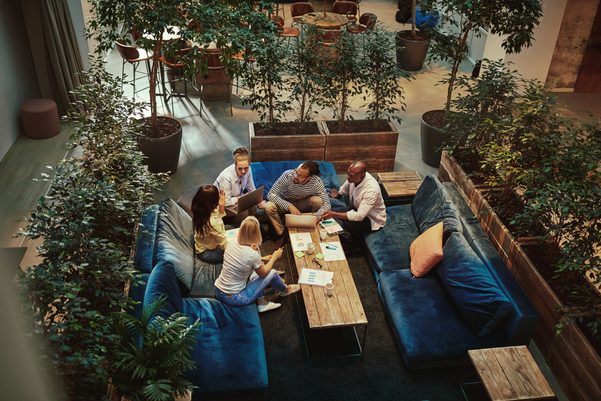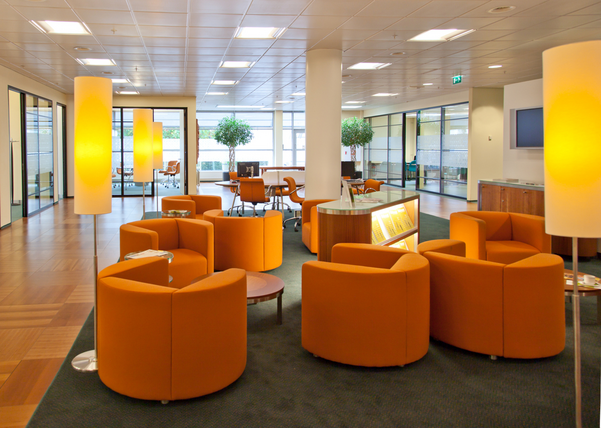- Introduction to Modern Lounge Settings
- The Concept of Networking Hubs within Corporate Spaces
- Designing Modern Lounge Settings
- Transforming Lounge Areas into Networking Hubs
- The Future of Networking Hubs within Corporate Spaces
- Conclusion: The Power of Lounge Settings As Networking Hubs
Introduction to Modern Lounge Settings
The Importance of Lounge Spaces in Corporate Settings
In a time where the lines between professional and personal spaces have become intricately interwoven, lounge settings within corporate environments have ascended beyond mere relaxation spots to pivotal nodes for interpersonal connection and collaboration. Quest Events, being at the forefront of creating immersive environments, recognizes the monumental role of well-crafted lounge spaces in mirroring a company’s ethos and fortifying internal networks, client interactions, and team collaborations.
Lounge spaces within corporate settings serve as multifunctional arenas where employees can disengage from routine tasks yet concurrently cultivate relationships that fortify a company’s internal and external networking. The importance of these spaces stems from their capacity to foster informal interactions and serendipitous meetings, which can lead to innovative ideas and strategic partnerships.
Moreover, in an era where employee well-being and organizational culture are paramount, lounges symbolize a firm’s commitment to providing spaces that cater to an employee’s holistic experience. They encapsulate a sanctuary where relaxation meets productivity, diverging from traditional office settings to nurture creativity, well-being, and, inadvertently, meaningful connections.
Evolution of Lounge Areas in Office Spaces
Delving into the historical transition of lounge areas unveils a fascinating journey from mere waiting areas or break rooms to now being integral elements shaping organizational culture and networking. Previously, lounge spaces were considered aesthetic additions to office environments, primarily designed for brief respites or awaiting guests.
However, as the dynamic of work cultures transmuted, particularly with the advent of technology and the shift towards more collaborative and open-plan offices, lounge areas, too, began to evolve. Nowadays, they are engineered as strategic spaces that facilitate relaxation and casual interactions and serve as informal meeting spots, fostering intra- and inter-departmental connections.
The conception of modern lounge spaces integrates not just a change in physical design but a shift in functionality, interlacing casualness with opportunities for spontaneous brainstorming sessions or impromptu meetings. It is essential to acknowledge that this evolution has yet to be linear nor universally applicable as diverse corporations adapt their lounge spaces in alignment with their unique organizational needs, cultures, and values.
The Concept of Networking Hubs within Corporate Spaces
The Importance of Networking in Corporate Cultures
Networking within corporate cultures transcends beyond business card exchanges during formal events; it is embedded in daily interactions, shared experiences, and cultivating a supportive and collaborative environment. In corporate cultures, networking is pivotal in career advancement, fueling innovation, knowledge sharing, and establishing a cohesive work environment.
A well-established networking culture augments knowledge dissemination across various departments, fostering a system where ideas remain consistent but permeate through diverse teams, generating a pool of multifaceted insights and expertise. Particularly for Quest Events, whose services are interlaced with creativity, innovation, and client interaction, internal networking becomes the backbone that sustains and propels collaborative efforts.
What are Networking Hubs?
Networking hubs within a corporate context can be perceived as ecosystems that organically instigate and nurture professional interactions and relationships. They are not confined to a physical space or a virtual platform. Still, they are symbiotic, enabling individuals to connect, collaborate, and communicate more informally and genuinely.
In essence, networking hubs serve as conduits for knowledge exchange, mentorship, and collaborative innovation, molding a culture inherently interwoven with cooperative spirit and collective growth. In corporate spaces, lounge settings are emerging as prominent networking hubs, bridging the gap between formal and informal, structured and spontaneous, crafting an environment where relationships are not transactional but constructed on a foundation of genuine connection and mutual growth.
Designing Modern Lounge Settings
Critical Aspects of Creating an Inviting Lounge Area
Quest Events, with its unparalleled expertise in creating compelling environments, underscores the importance of designing lounge areas that are not merely spaces but experiences—melding comfort, aesthetics, and functionality. Key to creating an inviting lounge area is a meticulous blend of ergonomic furniture, soothing color palettes, strategic lighting, and adaptable layouts. Each element must be thoughtfully curated and placed, ensuring that the lounge is not merely a backdrop but an active participant in facilitating interactions and exchanges.
Ergonomic furniture ensures comfort and physical well-being, while a palette that resonates with corporate identity yet is calming and inclusive lays down a welcoming vibe. Lighting, too, plays a crucial role—it must adapt to various moods and needs, ensuring that the space is versatile enough for casual chats, deep discussions, or rejuvenating breaks. The layout must cater to diverse preferences, perhaps providing secluded nooks for private talks, open areas for larger gatherings, and varied seating arrangements that cater to different interaction styles and requirements.
Integrating Technology into Lounge Settings
In our digitally dominated era, technology forms the backbone of most interactions and operations within a corporate environment. Technology integration becomes vital for operational efficiency and enhancing the networking experience when shaping modern lounge settings into networking hubs. Lounge areas adorned with innovative, intuitive technology, such as wireless charging stations, interactive displays, intelligent lighting, and climate control, elevate user experience and facilitate smooth, uninterrupted discussions and exchanges.
Particularly for Quest Events, where clients expect avant-garde solutions, showcasing a blend of modern aesthetics and technology in our spaces is a testament to our commitment and expertise in the domain. For instance, utilizing Augmented Reality (AR) to create interactive displays or implementing intelligent management systems that adapt environmental controls to user preferences and usage patterns would be convenient and an embodiment of innovative technology integration.
Design Aesthetics for a Modern Look
A modern aesthetic for lounge spaces only adheres to a single style template. Still, it reflects an organization’s identity, mission, and the experiential journey it wishes to curate for its employees and guests. In the case of Quest Events, our aesthetics would intertwine with our commitment to delivering creative and innovative event solutions, showcasing a blend of modernity, creativity, and functional elegance.
Contrasts, textures, art installations, and conscious use of space are all integral to crafting a modern aesthetic. Think of practical yet striking furniture pieces, playful yet sophisticated use of colors, and art that sparks conversation and thought. An aspect often overlooked is incorporating biophilic design elements, integrating nature into the space to foster a rejuvenating and calming environment, which enhances the aesthetic appeal and positively impacts well-being and creativity.
Transforming Lounge Areas into Networking Hubs
The Role of Lounge Areas in Promoting Networking
Lounge areas, with their informal and relaxed ambiance, naturally dismantle hierarchical and departmental barriers, paving the way for spontaneous interactions and the birth of multidimensional ideas. As networking hubs, lounge areas not only foster internal connections but also serve as a welcoming space for external stakeholders, clients, and partners, allowing relationships to brew in an atmosphere that is friendly and authentic.
In transforming lounge areas into networking hubs, the design must intuitively guide users toward interaction while respecting their need for solitude and relaxation. It’s about creating a space that invites, intrigues, and inspires, paving the way for connections forged not out of necessity but born out of genuine interaction and shared experiences.
Insights into Configuring Lounge Areas for Easy Interaction
Creating a fluid environment that naturally nudges individuals towards interaction without seeming forced is an art delicately woven into the tapestry of design and spatial planning. Configuring lounge areas should pivot on creating zones – each earmarked with a specific intent, be it casual one-on-ones, group discussions, or solitary contemplation while ensuring a seamless flow between them.
Emphasis should be on ‘collision’ spots – areas where individuals naturally converge and linger. For instance, placing interactive or dynamic elements like AR installations or creative visual displays near seating areas can naturally draw people and encourage spontaneous interactions.
Moreover, spatial design should allow for a blend of privacy and openness. Private nooks for focused discussions and open, vibrant areas for larger gatherings will enable the space to cater to varied networking and interaction needs. Ensuring ease of movement between these zones while maintaining a degree of separation is pivotal in sustaining the multifunctionality of the space.
Facilitating Casual Meetings and Collaborations

Beyond physical design, facilitating casual meetings and collaborations is also entwined with organizational cultural and operational norms. Establishing a culture where impromptu discussions and informal collaborations are encouraged and valued is fundamental. Lounge areas should be equipped to cater to the spontaneous ignition of ideas by providing tools for impromptu brainstorming sessions or screens for casual presentations.
Moreover, fostering a culture of respect for the space is crucial – encouraging individuals to utilize it for its intended purpose without hampering its availability or functionality for others. Thus, it is not merely about infusing the physical space with the necessary tools and design elements but also about intertwining it with operational policies and cultural norms that nourish an environment of respect, collaboration, and creativity.
The Future of Networking Hubs within Corporate Spaces
Upcoming Trends in Modern Lounge Settings
In the pulsating heart of corporate evolution, lounge settings are becoming increasingly significant, morphing and adapting to the concurrent waves of change in work paradigms. As we gaze into the future, several trends loom on the horizon of modern lounge settings. Flexibility reigns supreme, where furniture is mobile, adaptable, and integrated with technology. This allows users to transform and adapt the space as per immediate needs.
Moreover, sustainability is ascending as a non-negotiable element. Future lounge areas will not only incorporate sustainable materials and practices. Still, they will also reflect a design philosophy inherently considerate of its environmental and social impact.
Additionally, hybrid working models carve out a crucial niche in design considerations.
Lounge areas will be pivotal in bridging the physical and virtual worlds, providing spaces that facilitate smooth interaction and collaboration between in-person and remote participants. Ensuring that technology and design seamlessly blend to cater to this hybrid model will be fundamental in maintaining the relevance and efficacy of these spaces as networking hubs.
Potential Impact of Remote Work on Lounge Spaces
With remote work solidifying its stance in the corporate landscape, its impact on physical office spaces, especially lounge areas, is multifaceted. Lounge spaces now are not merely interaction places but need to double up as broadcasting hubs, facilitating virtual interactions and collaborations. The integration of sophisticated technology to enable high-quality virtual communication becomes paramount.
Furthermore, with potentially fewer employees working on-site, lounge areas may transform into multifunctional hubs, providing a blend of focused work areas, collaborative zones, and relaxed networking spots. In this context, design should facilitate a smooth transition between different work modes while maintaining an ambiance conducive to interaction and relaxation.
Ensuring that these spaces cater to remote and on-site employees equally, providing an inclusive environment that facilitates equal participation and interaction, becomes pivotal. Thus, lounge areas must evolve from physical spaces to integrated physical-virtual hubs, ensuring continuity and seamlessness in interactions and collaborations.
Conclusion: The Power of Lounge Settings As Networking Hubs
Key Takeaways on Building Networking Hubs
The journey through conceptualizing, designing, and implementing lounge areas as potent networking hubs unravels several key takeaways. Paramount among them is the imperative to intertwine design, technology, and organizational culture seamlessly, ensuring that the physical space is not merely a container but an active facilitator of interactions and networking.
Moreover, flexibility, sustainability, and inclusivity emerge as non-negotiable pillars upon which modern lounge settings must be built, ensuring that they are adaptable, environmentally and socially responsible, and cater to a diverse workforce’s varied and dynamic needs. Additionally, ensuring that these spaces seamlessly integrate the physical and virtual realms, providing a cohesive and inclusive environment for on-site and remote employees, is pivotal in sustaining their relevance and efficacy as networking hubs.
Final Thoughts: Towards More Connected Corporate Spaces
As we etch closer to a future where the boundaries between physical and virtual, professional and personal, formal and informal continue to blur, crafting spaces that navigate these interstices becomes imperative. Transformed into vibrant networking hubs, lounge settings can become crucibles where ideas meld, collaborations forge, and innovations spark.
The power of such spaces lies not merely in their physical attributes but in the experiences they curate, the interactions they foster, and the innovations they inadvertently facilitate. As we enter a future that’s invariably interconnected and interdependent, constructing spaces that mirror these attributes becomes relevant and fundamentally essential. Thus, through intentional design, strategic technology integration, and a supportive organizational culture, lounge areas can become the pulsating hubs of interaction, collaboration, and innovation within corporate spaces.


